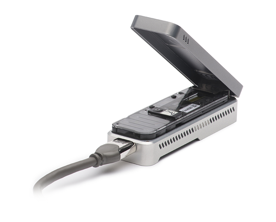Using ribosomal operons for species identification

Professor Lee Kerkhof from Rutgers University employed nanopore sequencing for bacterial microbiome profiling using whole rRNA operon sequences instead of only 16S1,2. The forward primer was generated in the 16S rRNA gene sequence and the reverse primer was within the 23S rRNA gene, resulting in a 4.2 kb fragment.
Figure: Amplicon structure for ribosomal operon sequencing (4.2 kb), containing almost full length 16S and 23S sequences. Image adapted from Kerkhof1.
The team sequenced 6 environmental samples, each comprised of farm soil DNA and bioreactor DNA mixed in varying proportions. Twelve hours of sequencing generated over 1000 operational taxonomic units (OTUs)*, with good concordance between replicates. The team was able to build consensus operons where each rRNA operon contained a 16S and a 23S gene.
The study concluded that nanopore sequencing of operons allowed better taxonomic resolution than standard 16S sequencing using short-read technology. The team also reported that their approach yielded accurate quantification of OTUs.
In summary, Professor Kerkhof commented that:
‘Our analysis demonstrated that the MinION has the ability to provide rRNA operon sequence data of sufficient quality for characterising the microbiota of complex environmental samples and provided results that are reproducible, quantitative, and consistent’3.
The team are now extending their research to elucidate the impact of external factors (e.g. toxin exposure) on the composition of the mouse microbiome1.
*Organisms are clustered into a single OTU based on similarity of DNA sequences above a pre-determined threshold.
This case study is taken from the Microbiome white paper.
References
1. Kerkhof, L.J. Bacterial microbiome profiling by MinION sequencing of ribosomal operons. (2017). Available at: https://vimeo.com/250287102 [Accessed: 24 January 2018]
2. Jenjaroenpun, P et al. Complete genomic and transcriptional landscape analysis using third-generation sequencing: a case study of Saccharomyces cerevisiae CEN.PK113-7D Nucleic Acids Res (2018). doi: 10.1093/nar/gky014. [Epub ahead of print]
3. Kerkhof, L.J. et al. Profiling bacterial communities by MinION sequencing of ribosomal operons. Microbiome 5:16 (2017).
